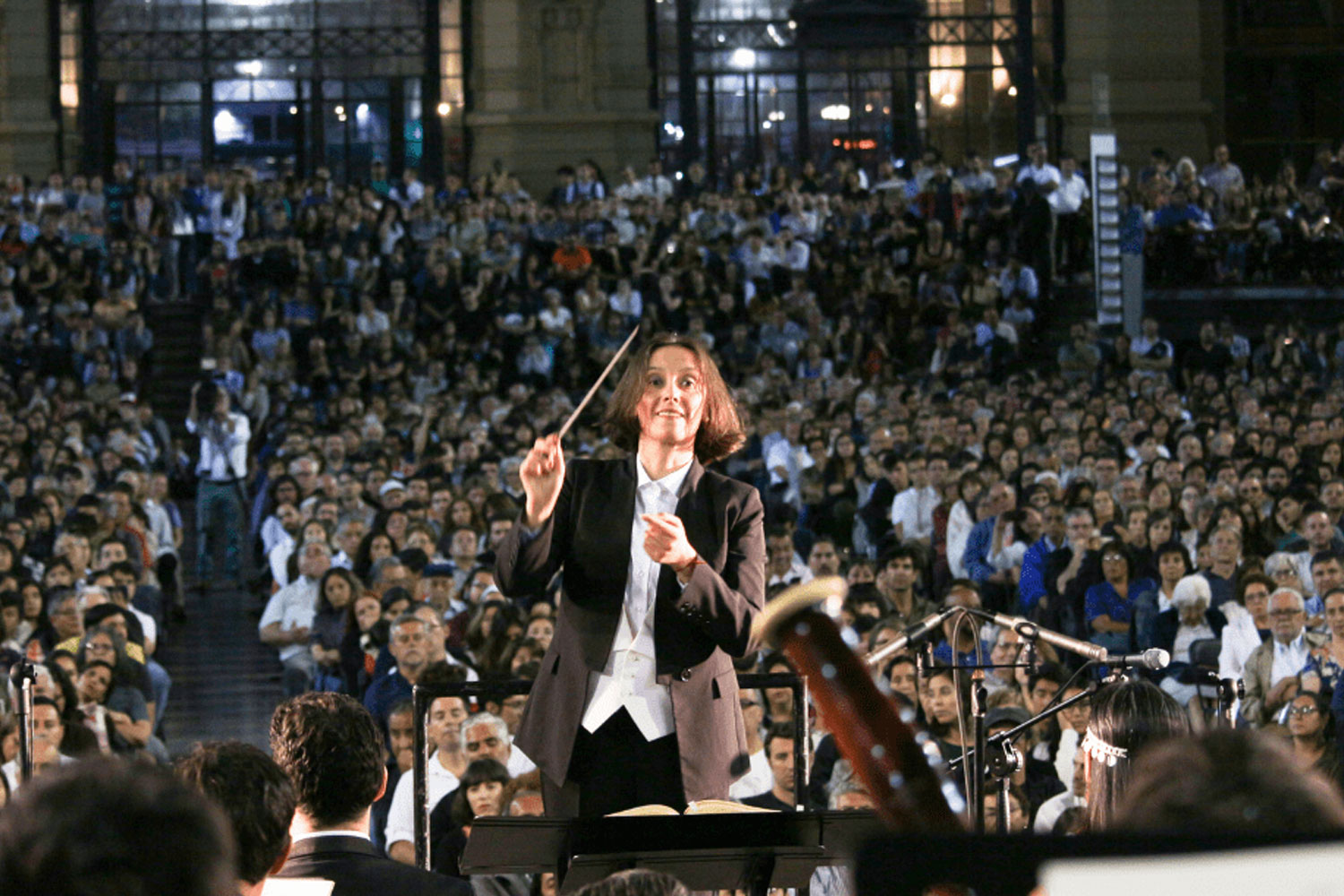Alejandra Urrutia and music as a reflection of existence
This Saturday, March 15, the Medellín Philharmonic Orchestra presents the concert “Nature, Religion, Human Being,” a proposal that invites us to reflect on the great questions of humanity. Within the framework of this presentation, the Orchestra spoke with the guest Chilean conductor, Alejandra Urrutia, who shared her vision of this program.
Filarmed: This program explores universal elements. How does music capture and convey these ideas to the audience?
Alejandra Urrutia: This programme brings together three works that, although different from each other, share a unique depth. Roots to Infinity IV by Claudia Sofía Álvarez immerses us in a sonic exploration of nature and identity. The composer poses two questions in her score: How do we connect with the land where we are born, taking root and nourishing ourselves from it without clinging to its borders? and How do we grow in multiplicity, expanding towards infinity without fear of faltering?
For its part, Great Russian Easter, Op. 36 Rimsky-Korsakov's opera takes us on a spiritual quest. The work is based on Orthodox liturgical chants and presents two main themes: one evoking the solemn voice of a priest and another reflecting the Christian ecstasy of the Russian Easter, in a crescendo of light and fervour.
Carl Nielsen’s Second Symphony, “The Four Temperaments,” explores the theory of human temperaments. Each movement reflects a personality: the choleric, energetic and impetuous; the phlegmatic, slow-paced and contemplative; the melancholic, nostalgic and introspective; and the sanguine, vibrant and optimistic. Nielsen translates these natures into a fascinating musical journey.
F: In Roots to Infinity IV, nature is the protagonist. How do you interpret this work so that the audience feels that connection with the primal?
AU: The work explores the sonority of strings, emerging from silence to guide us on a sonic journey that is both abstract and evocative. In the section Taking root deep inside, the roots of the trees in the Peruvian jungle intertwine, and the sound allows us to imagine these invisible ties that lead us to Branch, where the trees begin to spread their branches and grow until they expand to infinity.
Throughout the work, the composer uses extended techniques—harmonics, sul ponticello, white noise, glissandi—assigning each section a different technique. In this way, the music translates the natural process: from the rooting of the roots to their ascent towards infinity.
Q: The Great Russian Easter Overture is steeped in Orthodox spirituality. How do you balance religious solemnity with orchestral energy?
AU: The work is built on two fundamental elements: religion and pagan celebration. As a conductor, it is crucial to convey this concept to the musicians, not only to balance these opposing energies, but also to give them shape and depth, allowing the performance to reveal the full essence of the work.
F: Nielsen portrays the four temperaments in his symphony. How are they reflected in the music and how do you interpret them?
AU:The symphony is structured in four movements, each inspired by a temperament. Allegro cholericus It portrays the impulsive and volatile nature of someone who oscillates between fury and calm in an ephemeral way. Comfortable and phlegmatic Allegro describes an individual who is passive and indifferent to emotions. Melancholic Andante evokes the introspection and pathos of a dejected soul. Finally, Allegro Sanguine encapsulates the expansive and optimistic confidence of someone who feels that the world belongs to them. The tempo, rhythm, dynamics and articulation accentuate the distinctive features of each character.
F: Each concert reflects your artistic vision. Is there a moment in this program that resonates with you on a personal level?
AU: Carl Nielsen's symphony captivated me from the first moment I began to study it. The first time I conducted it was with the Provincial Symphony Orchestra of Santa Fe, in Argentina, during my time as principal conductor. An unforgettable memory.
F: Filarmed’s season is titled “Roots.” What does this concept represent for you?
AU: The word “Roots” immediately takes me back to my origins: family, cultural, musical and psychological. It makes me reflect on my identity as a woman and its meaning in today’s society, but above all, it invites me to delve deeper into the essence of the human being. Where do we come from? Why are we here? Where are we headed?
These questions have accompanied humanity throughout history, and as human beings, we must remain open to exploring and rethinking them as we move forward on the path of life.
F: Do you have any rituals before conducting a concert?
AU: On the day of a concert, I like to move more slowly than usual: I eat more slowly, I speak more deliberately, I walk without hurrying. It's a way of getting into a state of mind that is fully focused on the present, which, for me, is the key to an extraordinary performance. I also consider it essential to take an hour or two to rest before going on stage.
F: If you could describe this concert with an image, what would it be?
AU: I imagine the trunk of a tree as a metaphor for a rooted human being, rising towards the sky with the weight of life. Its branches and leaves are our wrinkles, our sorrows and joys. With a serene and wise countenance, it smiles at the stars and surrenders to the immensity of the sky.
The concert
Tickets from $44,000 for the general public and $25,000* for students
Get your tickets here at LaTiquetera.com
- 25% discount with Bancolombia cards
- Special prices for Comfama members
- Tickets at latiquetera.com, CC Los Molinos, CC Fabricato, CC Viva Envigado. Information: (604) 262 55 00
- *Ticket service not included. Terms and conditions at www.filarmed.org






